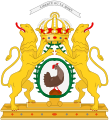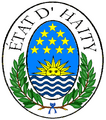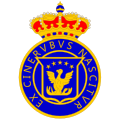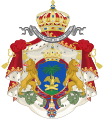Coat of arms of Haiti facts for kids
Quick facts for kids Coat of arms of Haiti |
|
|---|---|
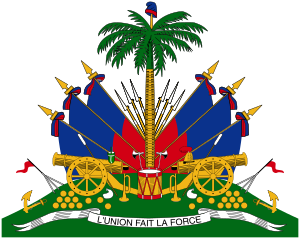 |
|
| Armiger | Republic of Haiti |
| Adopted | 1986 |
| Blazon | A palm tree surmounted by a liberty cap on a stake, proper |
| Supporters | A trophy of six rifles, six civil flags, two axes, two bugles, and a drum between two cannons pointing outwards on their gun-carriages, thereon two powder-bags, on the dexter one an infantry-hat, on the sinister one a cavalry-hat, between two piles of cannonballs and two anchors, all proper |
| Compartment | A grassy ground, marked by two pennons, proper |
| Motto | L'Union fait la force (French for 'Unity makes strength') |
The coat of arms of Haiti is the official national symbol of Haiti. It was first used in 1807. The design you see today has been around since 1986. Because this symbol does not follow the old rules for a traditional "coat of arms," some people call it the national emblem of Haiti instead.
Contents
What the Coat of Arms Shows
The coat of arms features six flags of Haiti, three on each side. These flags are placed behind a tall palm tree and cannons. Everything sits on a green lawn.
Symbols of Freedom and Strength
On the lawn, you can see many items. These include a drum, bugles, cannonballs, and ship anchors. These items represent Haiti's fight for freedom. Above the palm tree, there is a red cap called a liberty cap. This cap is a well-known symbol of freedom.
Haiti's Motto
A ribbon at the bottom of the coat of arms has the motto: L'Union fait la force (French for 'Unity makes strength'). This means "Unity makes strength" in French. It is also the motto for several other countries. Haiti's official national motto, found in its constitution, is Liberté, égalité, fraternité. This means "Liberty, Equality, Fraternity."
History of Haiti's Emblem
The first known symbol for Haiti appeared in 1807. It showed national flags, cannons, and palm trees. This symbol showed the country's fight for independence. The motto, "Strength through unity," was also part of it.
Changes Over Time
The use of this symbol was stopped two times in history. The first time was when Henri Christophe became King Henri I. He adopted a different royal coat of arms. His shield had a phoenix (a mythical bird that rises from ashes) with stars around it. His motto was "I will rise in my ashes." Two lions held up the shield, and another motto said, "God, my cause and my sword." In 1814, King Henri I changed his design slightly. He removed the lions and changed the motto to a Latin one meaning "Reborn from the ashes."
Another change happened in 1849. President General Faustin Soulouque crowned himself Emperor Faustin I. He chose new imperial arms. These showed two cannons and a French imperial eagle. Again, two lions held up the shield. The whole design was placed inside a purple cloak. His motto was similar to Henri I's: "God, my country and my sword."
Restoring the Original Symbol
Emperor Faustin I was forced to leave Haiti in 1859. After he left, the original symbol was brought back. Since then, the main design has stayed the same. However, the colors and some small details have changed over the years.
The coat of arms is shown on the national flag of Haiti. However, it is not on Haiti's civil flag, which is used by regular citizens.
Historical Coats of Arms
See also
 In Spanish: Escudo de Haití para niños
In Spanish: Escudo de Haití para niños
- Flag of Haiti
- Seal and emblem of the United States Department of the Army



